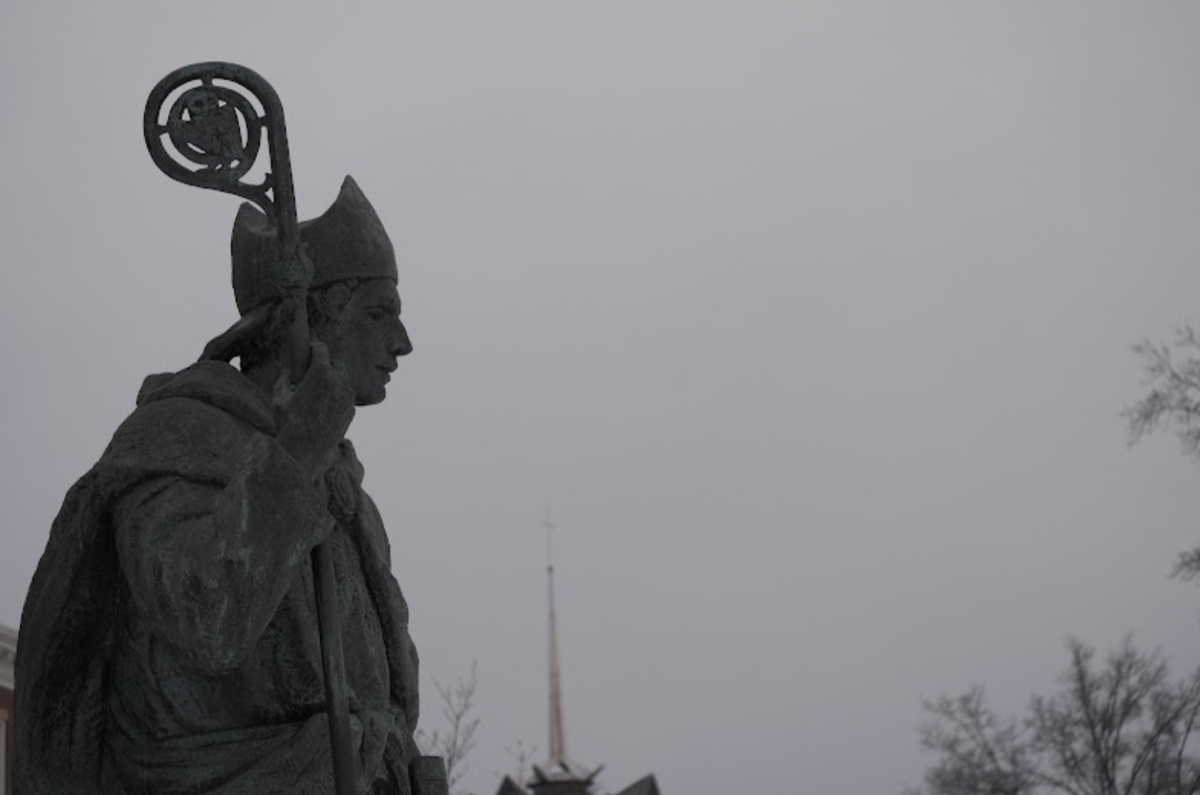I am going to write about the wisdom of the budget cuts. It is a topic that has provoked in me much thought and emotion. Over the past week, I have considered how I might write about such a grave and sensitive topic. There was a very large part of me that wanted to spit venom and fury upon this page. To protest in the very strongest of terms what I see as irreversible mistakes. I have worked hard, and in many drafts, to temper that impulse. I sought to write nothing harsh. However strongly I feel and with whatever language, I mean no insinuation against the goodwill and good faith of those making decisions. Let us begin.
Bishop Robert Barron (whom Saint Anselm College awarded an honorary Doctorate of Divinity) gave a recent talk at his alma mater, Notre Dame, where he worked admirably to synthesize ideas of Catholic higher education, leading to the thesis that “A Catholic university is one in which Christ holds the central and organizing place among all the disciplines and activities at the university.” Christ is not the central and organizing principle of our most recent proposed activities. If you disbelieve that our budget cut spurred changes to the core curriculum are an abandonment of the nature of a Catholic university, and thus a Christocentric university, crack open Saint John Henry Newman’s The Idea of a University or listen to Bishop Barron’s talk. Then, tell me that theology, philosophy, and the liberal arts are as expendable as we’re treating them. Merely parroting that “We value our Catholic and Benedictine heritage” does not in any way close the gap between what we profess and what we practice.
The above argument is a worthwhile one, made better by others, but I fear my audience cares little for the writings of Saints and podcasts of bishops. Instead, we’ll talk about money. Everybody cares about money. In the medium run, these proposed budget cuts will be disastrously expensive.
The budget cuts are predicated on the idea that higher education is approaching, what has been referred to for years as, a demographic cliff. This cliff is the result of birthrate trends a generation ago, leading to smaller K-12 enrollments and eventually, so the logic goes, smaller college enrollments. That demographic decline, especially concentrated in non-immigrant (RE: white) New England, will cause colleges distress seems to be a fact.
What is not inevitable (or at all likely) is that all colleges will be hit equally by enrollment declines. Would anyone seriously propose that UCLA and NYU (number one and six nationally for most applicants) will see enrollment declines? Will Amherst? Will Holy Cross? No, no, and no. The estimated 15% decline in college enrollment will hit some colleges not at all and wipe others off the map. 15% is an estimated average that will almost certainly manifest in a bimodal distribution.
Thus, this is not a problem that can be solved by building a fortress balance sheet, for if significant enrollment declines hit us, the blow will not be patchable by five million dollars. Rather, we ought to direct every effort to ensuring that Saint Anselm College is among that privileged tier that will be totally unaffected by enrollment declines. To analogize, the demographic cliff is not a storm to be weathered; it is an elimination round in a race where the weak are culled. If this is true, then what must be avoided is austerity. A racecar ought not to swap to cheaper tires before a big race. A knight ought not to switch his charger for a mule. A writer her Blackwing for a Ticonderoga.
Moreover, even if cuts are necessary, as they may well be, there is no excuse for cutting from academic instruction (40% of the proposed cuts) while we waste so much elsewhere. Put bluntly, in a world with limited resources, a college might either be a place of learning or a circus. You might balk at the comparison. Certainly, the college spends a lot of time and treasure on ‘programming,’ but does it function as a circus? Yes.
I could make this point by comparing college functions to circus performers (and such a comparison was made in an earlier draft but seemed mean-spirited), but that’s not the point. Rather, the college as circus model is thus: the college will provide entertainment, referred to by professionals as programming, as an alternative to education in an effort to maintain retention. Why do full-time Residence Directors harangue RAs to put on ill-attended programming? Retention. Why does every freshman have a week-long orientation (a modern invention)? Retention. Why does Anselmian Journeys exist? Retention. Hilltop Academy? Retention. Transitions? Retention. Trio? Retention.
“Wait!” says the skeptic, “are not entertainment and education compatible? Can’t students come from their 2nd core theology class to a Spring Concert and taco truck?” Yes, in a world with unlimited resources. But at Saint Anselm College, where we are cutting the budget by $5,000,000, the administration, to put it very bluntly, must decide whether to cut from the college’s entertainment budget or instructional budget. Shall they be educators or ringmasters? One dollar cannot be spent in two places at once.
On the topic of that, it violates the laws of thermodynamics for the college to cut the budget for new strategic initiatives— otherwise, it wouldn’t be a cut; it would be a shift, not affecting the balance sheet. Can we please cut the bull about budget cuts being a good thing? They can be necessary things, but they cannot make a college flexible; they cannot make room; they cut. They end. They destroy.
I fear that if I write any more in this vein, I will slip into harshness, and so I will conclude with some recommendations.
(1). Saint Anselm College was founded as an immigrant-serving institution. The stream of Franco-Americans has long dried up, but oughtn’t we honor that tradition? 12% of Boston’s (large) foreign-born population is Dominican. Many more come from China, Vietnam, El Salvador, Cameroon, and Brazil. These countries all have large Catholic populations (30% of Vietnamese Americans are Catholic). Rather than competing with other colleges to recruit via athletics, would it not be more effective to reach out to these populations in the region? Admissions ought to craft tailored campaigns to reach out to Catholic immigrant populations.
(2). Firms and economies have comparative advantages. America will see more return for every dollar it invests into fighter jet production than it will for every dollar invested into textile manufacturing. The reverse is true for Bangladesh. Saint Anselm College has obvious comparative advantages over other colleges in the humanities. We have obvious comparative disadvantages in capital-intensive majors. We ought, therefore, to invest more in the humanities, even as other colleges withdraw.
(3) Massive opportunities exist in human capital. The academic labor market is worse than ever, so hyper-specialized academic labor is more accessible than ever. Rather than investing in ‘strategic initiatives, ’ the college could choose to maintain a faculty well above the college’s historic means. Moreover, as the academic research pipeline collapses (replication crises, funding crises, plagiarism crises, etc.), now is the time to be on the avant-garde of outward-facing academics. We ought to hire based not only on teaching and research ability but also on public outreach ability.
(4). Academic rigor is on the outs just about everywhere else. Since Saint Anselm College is a brand, might it not be worth it to be a brand known for quality? Too many students pass Conversatio without reading. Too many students pass.



